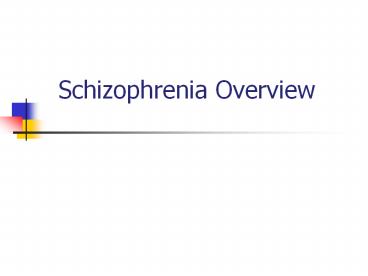Schizophrenia Overview - PowerPoint PPT Presentation
Title:
Schizophrenia Overview
Description:
Schizophrenia Overview Schizophrenia is the most severe and debilitating mental illness in psychiatry and is a brain disorder History Bleuiler Autism Ambivalence ... – PowerPoint PPT presentation
Number of Views:154
Avg rating:3.0/5.0
Title: Schizophrenia Overview
1
Schizophrenia Overview
2
Schizophrenia is the most severe and debilitating
mental illness in psychiatry and is a brain
disorder
3
History
- Bleuiler
- Autism
- Ambivalence
- Affect
- Association
4
Diagnosis of Schizophrenia
- A. Characteristic symptoms
- -Delusions
- -Hallucinations
- -Disorganized speech
- -Grossly disorganized or catatonic
behavior - -Negative symptoms
- B. Social/occupational dysfunction
- C. Overall duration gt 6 months
- D. Exclude mood disorders, drugs, pervasive
developmental disorders
5
Positive Symptoms
- Additions to normal function
- Delusions
- Hallucinations
- Distorted language/communication
- Disorganised speech / behaviour
- Catatonic behaviour
- Agitation
6
(No Transcript)
7
Negative Symptoms
- Losses of normal function
- -Affective flattening
- -Alogia
- -Avolition
- -Anhedonia
- -Attentional impairment
- Blunted affect, emotional withdrawal, poor
rapport, passivity, apathetic, social withdrawal
8
Cognitive Symptoms
- Thought disorder
- Odd use of language
- incoherence, loose associations, neologisms
- Impaired attention / cognition
- reduced verbal fluency
- learning/memory
- executive functions
9
Subtypes of schizophrenia
- Paranoid
- Disorganized
- Catatonic
- Undifferentiated
- Residual
10
(No Transcript)
11
Childhood onset schizophrenia
- Onset before 12 years
- Increased developmental abnormalities
- Lower IQ
- 1 in 10000
- Increased heritability
- Decreased gray matter
12
Epidemiology
- 1 prevalence worldwide
- Most begin in late adolescence to 20s
- MF
- Females age of onset is generally later better
outcome - Downward drift social-economically
- Die younger 10 suicide
13
Etiology of schizophrenia
- Genetic
- Structural brain changes
- Functional brain changes
- Dopamine hypothesis
14
Risk Factors
- Genetic
- Canabis
- Infection Birth Season
15
prognosis
- Age of onset
- Function level before onset
- IQ
- Drug response
- Family support
- sex
16
Structural changes in brain
- Larger ventricles
- Subgroup inverse correlation between ventricle
size and response to drugs
17
(No Transcript)
18
Structural changes in brain
- Increased loss of gray matter in adolescence
19
(No Transcript)
20
Dopamine hypothesis
- Amphetamine (very high doses) ? paranoia,
delusions, auditory hallucination - Amphetamines worsen schizophrenia symptoms
- Effects blocked by dopamine antagonist
chlorpromazine (Thorazine) - Typical antipsychotics block D2 receptors and
alleviate positive symptoms.
21
A 20th-century artist, Louis Wain, who was
fascinated by cats, painted these pictures over a
period of time in which he developed
schizophrenia. The pictures mark progressive
stages in the illness and exemplify what it does
to the victim's perception.
22
Treatment of Schizophrenia
23
Medications for schizophrenia
- Conventional antipsychotics
- - Haldol, Thorazine, Mellaril, etc.
- Second generation antipsychotics
- -Risperidone, Zyprexa, Seroquel,
Geodon, Abilify, Clozaril - Medications are better for positive symptoms than
negative symptoms
24
First generation antipsychotic side-effects
- Extrapyramidal side-effects Parkinson symptoms,
dystonia, restlessness - Sedation
- Weight gain
- Dry mouth, constipation
- Cardiac toxicity
- Postural hypotension
25
Second generation antipsychotic side-effects
- Weight gain
- Increase blood sugar diabetes
- Increased lipids
- Sedation
26
Non-pharmacologic treatments for schizophrenia
- Psychotherapy supportive
- Social skills training
- Family Therapy expressed emotion
- Psychosocial rehabilitation
27
Future Directions in the Treatment of
Schizophrenia
- More optimistic view of outcome
- Much stronger focus on early intervention and
prevention e.g. early psychosis clinics and
prodromal studies - Increased understanding of neurobiological basis
beyond dopamine hypothesis with non-dopamine
treatments - Renewed emphasis on rehabilitation, supported
employment etc.
28
(No Transcript)































